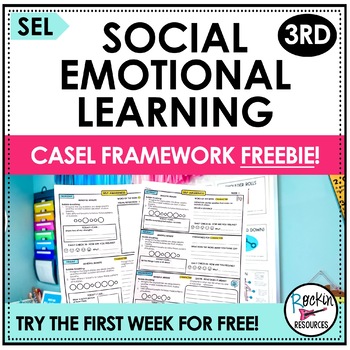FREE MISC. LESSON – “3rd Grade Social Emotional Learning Journal – SEL JOURNAL Week 1 – FREE SAMPLE”
by Rockin Resources
3rd Grade

FREE SAMPLE of our 3rd Grade Social Emotional Learning Journal. Try Week 1 for free!
LEARN MORE ABOUT THE YEAR-LONG SEL JOURNAL IN THE LINK ABOVE OR SEE BELOW:
This SOCIAL EMOTIONAL LEARNING journal with Casel Framework covers all 5 CASEL COMPETENCIES. To take students confidently through the school year, each of the 5 competencies are scaffolded and repeated 7 times to provide 35 weeks of social emotional learning opportunities. This SEL journal writing helps students build confidence and empathy.
It is perfect for morning work to start off the day on the right foot! DIGITAL NOW AVAILABLE- PDF, GOOGLE, AND POWERPOINT INCLUDED!
COMPETENCIES:
- Self-Awareness
- Self-Management
- Social Awareness
- Relationship Skills
- Decision-Making
THERE IS A CHOICE OF TWO COVER PAGES FOR JOURNALS.
6-PRONGED APPROACH INCLUDES:
1. DAILY CHECK IN:
Teachers can gain a sense of where students are emotionally each day to determine if there is something the teacher needs to discuss with that student.
2. MINDFUL MINUTE:
Practical daily strategies for coping and calming. These vary. Some are the same throughout the week. Others change daily.
3. SCAFFOLDED SEL VOCABULARY:
The vocabulary helps students develop the necessary words to express themselves. It increases vocabulary consciousness through encountering, engaging, and applying context via definition, sentence, synonym and ‘What does the word make me think of?’ There is one vocabulary word per week that is aligned to that competency. Each CASEL competency vocabulary word progresses/builds upon each previous competency cycle. i.e.- Look at Decision-Making and see how the vocabulary progresses with each cycle. The vocabulary is consistent in content across grades 3-5 with different words aligned to the reading level (based on a book, Children’s Writer’s Word Book by Alijandra Mogilner that levels words).
- VOCABULARY SENTENCE: There is a sample of a sentence in the teacher notes.
- SYNONYM: For some words, you may want students (or use for differentiation) to find antonyms too.
- WHAT DOES THE WORD MAKE ME THINK OF?: This can be anything that comes to mind. It can be shared in a discussion.
A WORD WALL and STUDY CARDS are also included!
4. TODAY I CAN:
The “I Can” statements are practical, ‘doable’ and aligned with CASEL ‘I Can’ ideals. (Many districts require teachers to write the daily ‘I Can’ ‘standards’ on the board. Often, they ‘sound good’ but lack practicality for students. Our ‘I Can’ statements combine realistic things students can do AND general goal statements. They will mean something to students.
There is overlap across grade levels with ‘I Can’ statements. This both reinforces previous years’ ‘I Can’ tasks but also introduces different/higher level ones that have been tweaked.
These can be used for discussion. Some have a quick written answer while others have a place to check off for completion or understanding. When checking off for completion, it may need to be checked off at the end of the day or before they start the next day. You might also want to set guidelines to meet your classroom dynamics for some of them. For example- Sit next to someone who is lonely. – You might want to designate a time- at lunch or free time.
5. QUOTE:
Quotes were included for inspiration and context. They have cited authors if known and their occupation. They were chosen for practical and thought-provoking analysis.
6. REFLECTION:
VISUAL: The illustration doesn’t have to be specific. It can symbolize the statement. For example- I can promise myself to not make the same mistake twice. Students can draw a promise sign and the number 2.
WRITTEN: Practical and thought-provoking reflection prompts to increase students’ comprehension and transformation.
WHAT IS THE CASEL FRAMEWORK?
A framework creates a foundation for applying evidence-based SEL strategies to the community. The “CASEL wheel” helps cultivate skills and environments that advance students’ learning and development.
Use the framework to:
- Foster knowledge, skills, and attitudes across five areas of social and emotional competence;
- Establish equitable learning environments and coordinate practices across four key settings that support students’ social, emotional, and academic development.
BEFORE YOU START:
These are meant to do in the morning, first thing, like DOL or Math Minutes, etc.
Remind students that there are no right or wrong answers. It is to help them grow socially and emotionally. If you need to grade it, it can be for completion.
THANK YOU FOR VISITING MY STORE!
Keep rockin’ it!
Pam
2nd Grade Social Emotional Learning Journal
4th Grade Social Emotional Learning Journal
5th Grade Social Emotional Learning Journal
6th Grade Social Emotional Learning Journal
Other SEL and Character Education Resources: CLICK HERE
Join The Best of Teacher Entrepreneurs Marketing Cooperative at
https://thebestofteacherentrepreneursmarketingcooperative.net/the-best-of-teacher-entrepreneurs-marketing-cooperative-one-year-membership/
and get THOUSANDS OF PAGE VIEWS for your TpT products!
Go to http://www.pinterest.com/TheBestofTPT/ for even more free products!
